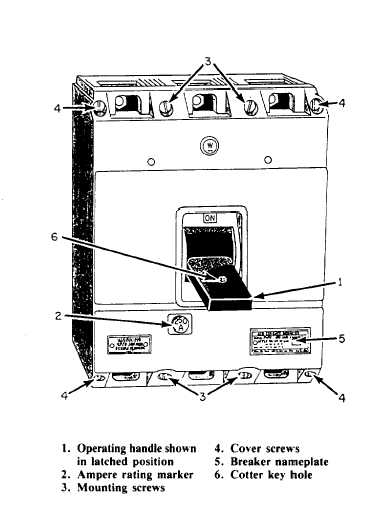Figure 12-9.—Circuit breaker.
lighting distribution panels. Large circuit breakers
connect ship’s service and emergency generators
to the power distribution system. They are also
used on bus ties and shore connection circuits.
Smaller circuit breakers, rated according to the
load they handle, are also installed on switch-
boards and on distribution panels throughout the
ship.
Circuit Breakers
Circuit breakers (fig. 12-9) are used to isolate
faulty circuits, to provide a mechanical means to
disconnect the electrical power for equipment
maintenance, and to serve as overload protection.
These circuit breakers are part of the switchboard
equipment. Circuit breakers, rather than fuses,
are used in circuits that carry large currents. They
can be operated for an indefinite period, and their
action accurately controlled.
Circuit breakers open automatically when the
current (load) on the circuit exceeds a preset value,
Circuit breakers used with shipboard equipment
are not susceptible to tripping when subjected to
heavy shocks (such as those caused by gunfire).
Circuit breakers are used on all rotating electrical
machinery and feeders to vital loads, such as gun
mounts and searchlights.
In addition to overload relays, reverse power
trip relays are provided on ac generator circuit
breakers. These units are designed to open and
prevent motorizing a generator in the event of a
power reversal. They are mounted within the
generator switchboard.
Voltage Regulators
Voltage regulators
associated switchboards.
are installed on the
They are used for ac
ship’s service and emergency generators. A voltage
regulator maintains generator voltage within
specified limits. The switchboard operator adjusts
or sets the generator voltage at any value within
certain limits. When additional loads are applied
to a generator, there is a tendency for the voltage
to drop. The automatic regulator keeps the
voltage of a generator constant at various loads.
Indicating Meters
All the important switchboards aboard ship
are provided with electrical meters. Electrical
meters, somewhat like gauges and thermometers,
show the operator what is taking place in the
electrical machinery and systems. Electrical meters
are of two general types—installed meters (on
switchboards) and portable meters. Some of
the most common meters used are voltmeters,
ammeters, kilowatt meters, and frequency meters
(fig. 12-10).
ELECTRIC MOTORS
Electric motors are used aboard ship to
operate guns, winches, elevators, compressors,
pumps, ventilation systems, and other auxiliary
machinery and equipment. There are many
reasons for using electric motors: they are safe,
convenient, easily controlled, and easily supplied
with power.
A motor changes electrical energy into
mechanical energy. There are important reasons
for changing mechanical energy to electrical
energy and back again to mechanical energy.
One reason is that electric cables can be led
through decks and bulkheads with less danger to
12-10

